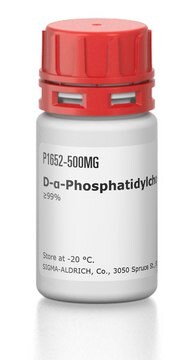Wichtige Dokumente
850475C
Avanti
18:1-16:0 PC
1-oleoyl-2-palmitoyl-sn-glycero-3-phosphocholine, chloroform
Synonym(e):
1--(9Z-octadecenoyl)-2-hexadecanoyl-sn-glycero-3-phosphocholine; OPPC; PC(18:1(9Z)/16:0)
About This Item
Empfohlene Produkte
Assay
>99% (TLC)
Form
liquid
Verpackung
pkg of 1 × 2.5 mL (850475C-25mg)
pkg of 2 × 4 mL (850475C-200mg)
Hersteller/Markenname
Avanti Research™ - A Croda Brand 850475C
Konzentration
10 mg/mL (850475C-25mg)
25 mg/mL (850475C-200mg)
Lipid-Typ
cardiolipins
phospholipids
Versandbedingung
dry ice
Lagertemp.
−20°C
SMILES String
[P](=O)([O-])(OC[C@H](OC(=O)CCCCCCCCCCCCCCC)COC(=O)CCCCCCC\C=C/CCCCCCCC)OCC[N+](C)(C)C
InChI
1S/C42H82NO8P/c1-6-8-10-12-14-16-18-20-21-23-24-26-28-30-32-34-41(44)48-38-40(39-50-52(46,47)49-37-36-43(3,4)5)51-42(45)35-33-31-29-27-25-22-19-17-15-13-11-9-7-2/h20-21,40H,6-19,22-39H2,1-5H3/b21-20-/t40-/m1/s1
InChIKey
RRVPPYNAZJRZFR-VYOBOKEXSA-N
Allgemeine Beschreibung
Anwendung
- as a lipid standard in ultra-performance liquid chromatography (UPLC) analyses
- as a component in liposomes to study the cell proliferation of several cell lines
- in liposomes for cross-linking experiment
Biochem./physiol. Wirkung
Verpackung
Rechtliche Hinweise
Signalwort
Danger
Gefahreneinstufungen
Acute Tox. 3 Inhalation - Acute Tox. 4 Oral - Carc. 2 - Eye Irrit. 2 - Repr. 2 - Skin Irrit. 2 - STOT RE 1 Oral - STOT SE 3
Zielorgane
Liver,Kidney, Respiratory system
Lagerklassenschlüssel
6.1D - Non-combustible acute toxic Cat.3 / toxic hazardous materials or hazardous materials causing chronic effects
WGK
WGK 3
Flammpunkt (°F)
does not flash
Flammpunkt (°C)
does not flash
Hier finden Sie alle aktuellen Versionen:
Analysenzertifikate (COA)
It looks like we've run into a problem, but you can still download Certificates of Analysis from our Dokumente section.
Wenn Sie Hilfe benötigen, wenden Sie sich bitte an Kundensupport
Besitzen Sie dieses Produkt bereits?
In der Dokumentenbibliothek finden Sie die Dokumentation zu den Produkten, die Sie kürzlich erworben haben.
Global Trade Item Number
| SKU | GTIN |
|---|---|
| 850475C-25MG | 4061837792588 |
| 850475C-200MG |
Unser Team von Wissenschaftlern verfügt über Erfahrung in allen Forschungsbereichen einschließlich Life Science, Materialwissenschaften, chemischer Synthese, Chromatographie, Analytik und vielen mehr..
Setzen Sie sich mit dem technischen Dienst in Verbindung.










